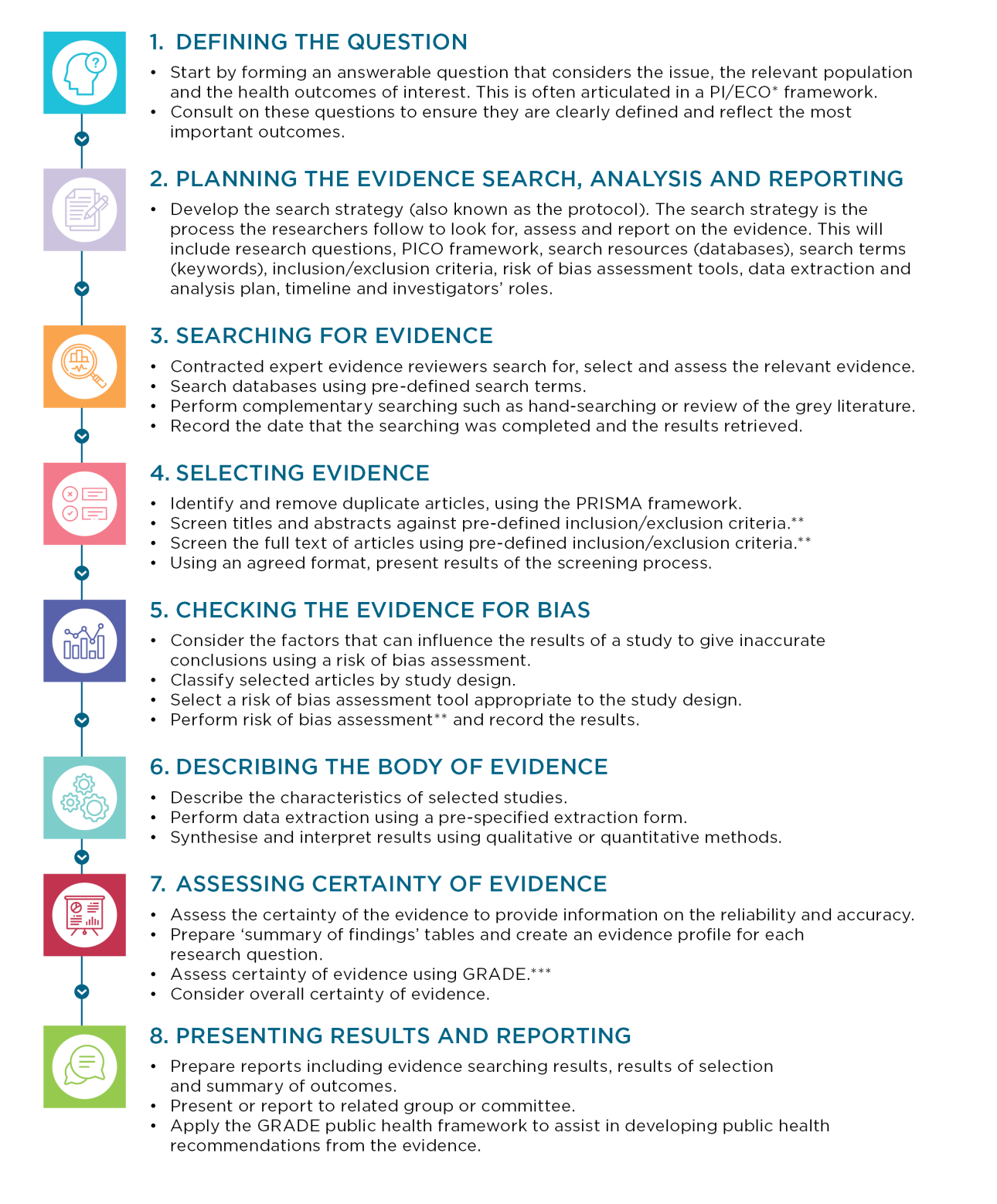NHMRC has rigorous standards in place to ensure that guidelines and advice are high quality and based on the best available scientific evidence.
NHMRC follows a robust and transparent development and decision making process. This involves determining the questions we want to answer, and then planning the evidence search, analysis and reporting. The evidence is then searched and selected before assessing the evidence for bias. The body of evidence will then be described and assessed for certainty, before the results and reporting is presented.
This process has been outlined in the reviewing the evidence flow diagram to show the steps involved.
Flow diagram: How we review the evidence for guidelines or advice 
* PI/ECO—Population, Intervention/Exposure, Comparison, Outcomes
** This step may involve two investigators performing independently and reaching consensus or may be conducted by a single investigator with a second investigator validating the outcomes.
*** GRADE—The Grading of Recommendations Assessment, Development and Evaluation
Processes used to develop clinical and public health guidelines can often vary depending on the available resources, nature of the evidence and the needs of the audience. NHMRC publishes detailed records of decisions and judgements made during the development process to ensure transparency
- Image description - flow diagram
- DEFINING THE QUESTION
- Start by forming an answerable question that considers the issue, the relevant population and the health outcomes of interest. This is often articulated in a PI/ECO* framework.
- Consult on these questions to ensure they are clearly defined and reflect the most important outcomes.
- PLANNING THE EVIDENCE SEARCH, ANALYSIS AND REPORTING
- Develop the search strategy (also known as the protocol). The search strategy is the process the researchers follow to look for, assess and report on the evidence. This will include research questions, PICO framework, search resources (databases), search terms (keywords), inclusion/exclusion criteria, risk of bias assessment tools, data extraction and analysis plan, timeline and investigators’ roles.
- SEARCHING FOR EVIDENCE
- Contracted expert evidence reviewers search for, select and assess the relevant evidence.
- Search databases using pre-defined search terms.
- Perform complementary searching such as hand-searching or review of the grey literature.
- Record the date that the searching was completed and the results retrieved.
- SELECTING EVIDENCE
- Identify and remove duplicate articles, using the PRISMA framework.
- Screen titles and abstracts against pre-defined inclusion/exclusion criteria.**
- Screen the full text of articles using pre-defined inclusion/exclusion criteria.**
- Using an agreed format, present results of the screening process.
- CHECKING THE EVIDENCE FOR BIAS
- Consider the factors that can influence the results of a study to give inaccurate conclusions using a risk of bias assessment.
- Classify selected articles by study design.
- Select a risk of bias assessment tool appropriate to the study design.
- Perform risk of bias assessment** and record the results.
- DESCRIBING THE BODY OF EVIDENCE
- Describe the characteristics of selected studies.
- Perform data extraction using a pre-specified extraction form.
- Synthesise and interpret results using qualitative or quantitative methods.
- ASSESSING CERTAINTY OF EVIDENCE
- Assess the certainty of the evidence to provide information on the reliability and accuracy.
- Prepare ‘summary of findings’ tables and create an evidence profile for each research question.
- Assess certainty of evidence using GRADE.***
- Consider overall certainty of evidence.
- PRESENTING RESULTS AND REPORTING
- Prepare reports including evidence searching results, results of selection and summary of outcomes.
- Present or report to related group or committee.
- Apply the GRADE public health framework to assist in developing public health recommendations from the evidence.
* PI/ECO—Population, Intervention/Exposure, Comparison, Outcomes
** This step may involve two investigators performing independently and reaching consensus or may be conducted by a single investigator with a second investigator validating the outcomes.
*** GRADE—The Grading of Recommendations Assessment, Development and Evaluation The process for developing clinical guidelines may vary.
- DEFINING THE QUESTION